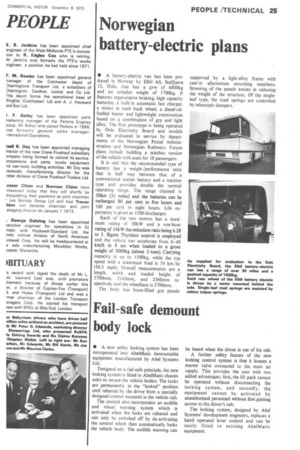Norwegian battery-electric plans
Page 27

If you've noticed an error in this article please click here to report it so we can fix it.
• A battery-electric van has been produced in Norway by Elbil AS, Stalfjaera 12, Oslo, that has a gvw of 4800kg and an unladen weight of 1700kg. It features regenerative braking, high capacity batteries, a built-in automatic fast charger, a motor at each back wheel, a diesel-oilfuelled heater and lightweight construction based on a combination of grp and light alloy. The first prototype is being operated by Oslo Electricity Board and models will be evaluated in service by departments of the Norwegian Postal Administration and Norwegian Railways. Future plans include building a minibus version of the vehicle with seats for 18 passengers.
It is said that the recommended type of battery has a weight /performance ratio that is half way between that of a conventional starter battery and a traction type and provides double the normal operating range. The range claimed is 50krn (31 miles) and the batteries can be recharged 80 per cent in five hours and 100 per cent in eight hours. Life expectancy is given as 1500 discharges.
Each of the two motors has a maximum rating of 30kW and a one-hour rating of 14kW the reduction ratio being 6.28 to 1. Sigma Thyristor control is employed and the vehicle can accelerate from 0-40 km/h in 8 sec when loaded to a gross weight of 3000kg (about 3 tons). Carrying capacity is up to 1500kg, while the top speed with a maximum load is 59 km /hr (36.5 mph). Overall measurements are a length, width and loaded height of 5700mm. 2160mm. and 2360mm respectively and the wheelbase is 2700mm.
The body has foam-filled grp panels supported by a light-alloy frame with cast-in alluminium mounting members. Stressing of the panels assists in reducing the weight of the structure. Of the singleleaf type, the road springs are controlled by telescopic dampers.








































































































